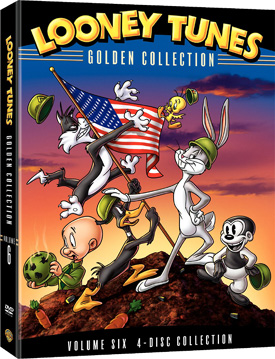Charlie Dog is an animated cartoon character in the Warner Brothers Looney Tunes series of cartoons. The character was featured in nine cartoons between 1941 and 1958. He is generally characterized as a friendly wise guy.

Hippety Hopper is a young kangaroo character in the Warner Bros. Looney Tunes series of cartoons. Robert McKimson introduced Hippety Hopper in Hop, Look and Listen (1948), which established the pattern for future Hippety Hopper cartoons. The character appeared in 14 theatrical cartoons between 1948 and 1964.

Hillbilly Hare is a 1950 Warner Bros. Merrie Melodies cartoon directed by Robert McKimson. The short was released on August 12, 1950 and stars Bugs Bunny.

Tweetie Pie is a 1947 Warner Bros. Merrie Melodies cartoon directed by Friz Freleng. The short was released on May 3, 1947, and stars Tweety with Sylvester, who is called "Thomas" in this cartoon.

Babbit and Catstello are fictional characters, based on the comedic duo Abbott and Costello, that appeared in Warner Bros. animated cartoons. The characters appeared in four cartoons between 1942 and 1946: once as cats, once as dogs, and twice as mice.
Hop, Look and Listen is a 1948 Warner Bros. Looney Tunes cartoon directed by Robert McKimson. The short was released on April 17, 1948, and stars Sylvester and Hippety Hopper, in the latter's first appearance.

Sylvester J. Pussycat Jr., simply known as Sylvester Jr., is an animated cartoon character in the Warner Bros. Looney Tunes and Merrie Melodies series. He was created by Robert McKimson.

Walky Talky Hawky is a 1946 Warner Bros. Merrie Melodies theatrical short directed by Robert McKimson. The cartoon was released on August 31, 1946, and features Henery Hawk and Foghorn Leghorn. This is the first appearance of both Foghorn Leghorn and the Barnyard Dawg.
Mice Follies is a 1960 Warner Bros. Looney Tunes cartoon directed by Robert McKimson. The short was released on August 20, 1960. It was the third and last of McKimson's parodies of Jackie Gleason's The Honeymooners, following The Honey-Mousers (1956) and Cheese It, the Cat! (1957).

Looney Tunes Golden Collection: Volume 5 is a Looney Tunes collection on DVD. Following the pattern of one release each year of the previous volumes, it was released on October 30, 2007.

Early to Bet is a 1951 Warner Bros. Merrie Melodies theatrical cartoon short directed by Robert McKimson. The short was released on May 12, 1951, and features the Gambling Bug.
Cheese It, the Cat! is a 1957 Warner Bros. Looney Tunes cartoon, directed by Robert McKimson. The short was released on May 4, 1957, and is the second of three McKimson cartoons parodying television's The Honeymooners.

Looney Tunes Golden Collection: Volume 6 is a four-disc DVD box set collection of Looney Tunes and Merrie Melodies cartoons. Following the pattern of one release each year of the previous volumes, it was released on October 21, 2008. It is the final release in the Golden Collection series. Succeeding the Golden Collection series would be the Looney Tunes Platinum Collection series on Blu-ray, first released November 2011. On July 3, 2012, a two-disc DVD version of Volume 1 of the Platinum Collection was released.
This is a listing of all the animated shorts released by Warner Bros. under the Looney Tunes and Merrie Melodies banners between 1960 and 1969. A total of 147 shorts were released during the 1960s.
This is a listing of all theatrical animated shorts released by Warner Bros. under the Looney Tunes and Merrie Melodies banners between 1970 and the present. It also lists shorts originally planned for theatrical release and other shorts that were not feature films, television series, or television specials.

Bugged by a Bee is a 1969 Warner Bros. Looney Tunes animated cartoon directed by Robert McKimson. It starred Cool Cat, and was the final cartoon from the original Looney Tunes/Merrie Melodies series to bear the Looney Tunes name, and the last from that era to be widely released. One more cartoon, Injun Trouble, would follow Bugged by a Bee, but it was in the Merrie Melodies series.
Mucho Locos is a 1966 Warner Bros. Merrie Melodies cartoon directed by Robert McKimson. The short was released on February 5, 1966, and stars Daffy Duck and Speedy Gonzales.
A Taste of Catnip is a 1966 Warner Bros. Merrie Melodies cartoon directed by Robert McKimson. The short was released on December 3, 1966, and stars Daffy Duck and Speedy Gonzales with cameos by Sylvester the Cat and Hector the Bulldog. It was the final overall theatrical classic-era Warner Brothers cartoon featuring Sylvester and Hector during the golden age of American animation.

It's Hummer Time is a 1950 Warner Bros. Looney Tunes cartoon directed by Robert McKimson and written by Warren Foster. The short was released on July 22, 1950. The cartoon stars a tuxedo cat who attempts to catch a hummingbird, only to get in the way of a bulldog who subjects him to various forms of torture for accidentally hurting and bugging him while doing so to the tune of Raymond Scott's Powerhouse, the cat seeming to know what's in store for him each time. All voice characterizations are performed by Mel Blanc.











